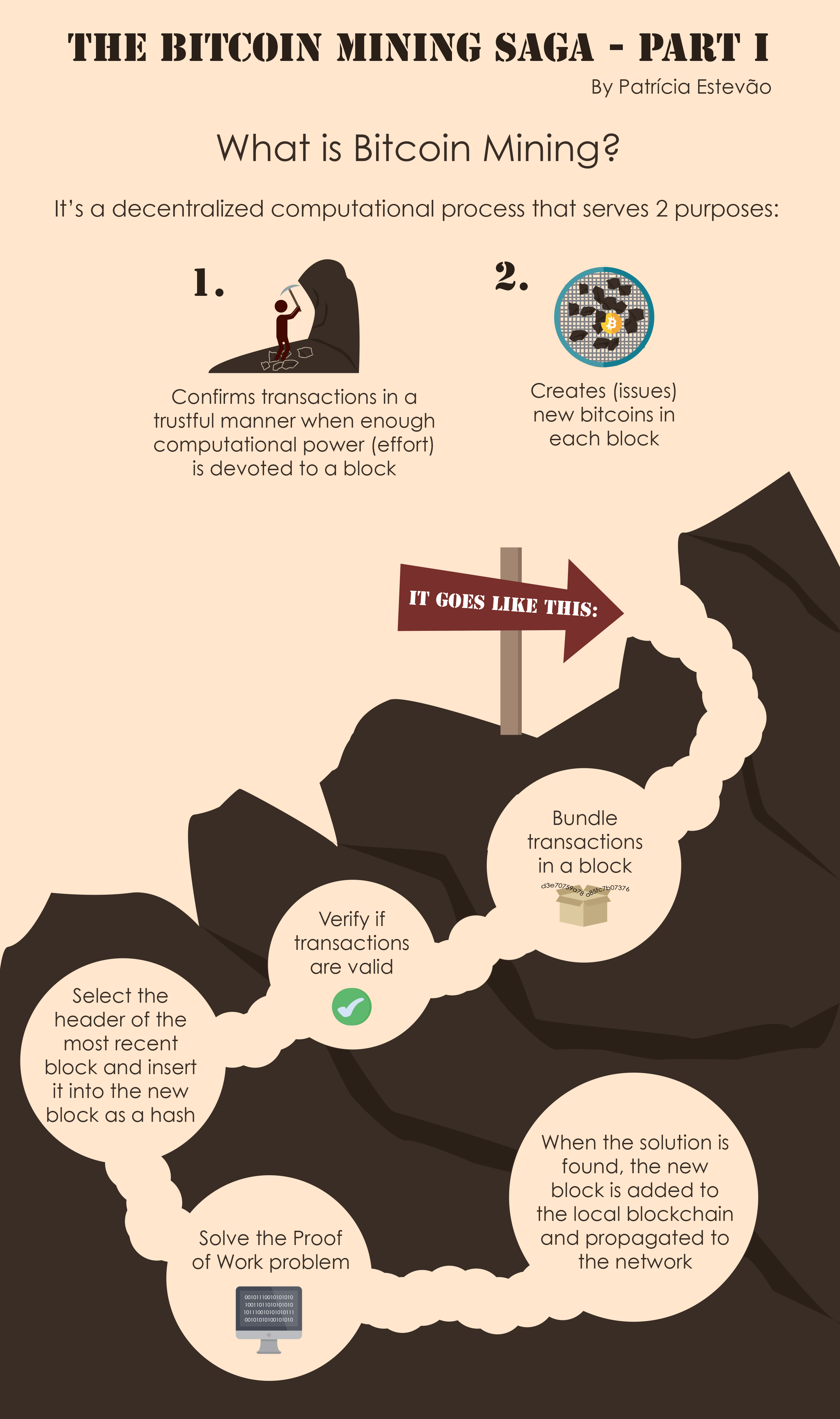Entry {2} - {Mining Cryptocurrencies}
Mining Cryptocurrencies
Unlike regular, institutional fiat currencies that will physically print out more money when necessary, Bitcoin and other cryptocurrencies are essentially created through a system called "mining," which is defined as, "...the process by which transactions are verified and added to the public ledger, known as the blockchain, and also the means through which new [cryptocurrencies] are released," (1). The mining process exists for two main reasons: to validate transactions using a specific currency and then to reward the miner who confirmed the activity by generating and delivering to him or her a set number of new coins.
If the blockchain was inconsistent, or if it faltered in its reported data about any transaction at any given point in its lifetime, then the blockchain would be unreliable and completely untrustworthy. One of the main attractions to the blockchain is that it builds upon itself from block to block of verified activity. Miners, who confirm the validity of these blocks and add them to the infinitely growing chain, must have a way to concentrate enormous amounts of data in order to better confirm a block's legitimacy. They do this by hashing the data. "A hash value is a numeric value of a fixed length that uniquely identifies data," (2). Any form of data, from a string to an array, can be stored as a hash. Miners then use their computing power to determine the hash value of the eventual block of data. Once the value is found, the block is confirmed and added to the chain. The miner that determined the hash is then rewarded with a volume of coins for giving their time and computing power.
When solving these complex algorithms and mathematical formulas, cryptocurrency miners are specifically trying to find the nonce, which is defined as, "('number only used once') a number added to a hashed block that, when rehashed, meets the difficulty level restrictions," (3). If finding the hashed value for a block remained simple and didn't require huge amounts of computing power, all the coins of a currency would be mined in hours. To avoid this occurrence, a cryptocurrency's blockchain technology is designed to add difficulty to each block validation. In addition, this increased difficulty helps to prevent wrongful practices like the alteration of a block or the blockchain itself. In fact, each nonce has the hash value of the previous block built into its data set so that a new block literally builds on the previous block on the chain. If the hashed value of the previous block is changed to try to edit the blockchain, the network of miners will reject the false work. This process of finding nonces using hashed data sets to validate transactions blocks by solving increasingly complex mathematical formulas is known as proof-of-work.
Infographic
This infographic assists in illustrating the process by which Bitcoin and other cryptocurrencies are mined through the validation of transactions using the currency.
 |
| (4) |
Relation to Computer Science
A big way in which mining cryptocurrencies is related to computer science is the hardware miners utilize to maximize their computing power. When Bitcoin was first created, a miner could use his or her regular desktop computer to find nonces and hash values. However, as bitcoin increased in relevancy, miners needed to upgrade their hardware to gain advantages in how fast they can compute data as well as to counter the increased difficulty of proof-of-work problems. Miners moved from CPUs to GPUs and eventually graphics cards as power necessity increased. Eventually, hardware was constructed just for cryptocurrencies known as ASIC, "which stands for Application-Specific Integrated Circuit, was designed specifically for mining bitcoin," (5). As proof-of-work continues to multiply in difficulty as well as the number of miners increases the competition for block validation rewards, it will be interesting to see how computer engineers design and implement new, powerful forms of hardware for mining cryptocurrencies.
References
- Bitcoin Mining. (2016, December 02). Retrieved October 30, 2017, from http://www.investopedia.com/terms/b/bitcoin-mining.asp
- Wenzel, M., & Latham, L. (2017, March 30). Ensuring Data Integrity with Hash Codes. Retrieved October 31, 2017, from https://docs.microsoft.com/en-us/dotnet/standard/security/ensuring-data-integrity-with-hash-codes
- Nonce. (2017, October 23). Retrieved October 31, 2017, from http://www.investopedia.com/terms/n/nonce.asp
- What is Bitcoin Mining? (n.d.). Retrieved October 31, 2017, from https://www.weusecoins.com/en/mining-guide/
- Bitcoin Mining. (2016, December 02). Retrieved October 31, 2017, from http://www.investopedia.com/terms/b/bitcoin-mining.asp
I've always been confused by what Bitcoin is based off of, exactly. Do the people just decide its value directly or is there some form of larger market for it? I don't know anything about economics so forgive me. Also - where are these blocks found? I think I asked that question on somebody's blog last week too - I'm really curious how this whole thing works. I'll be back next week!
ReplyDelete